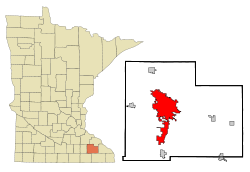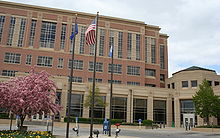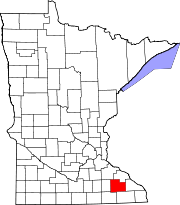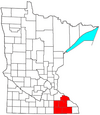
Minnesota is a state in the Upper Midwestern region of the United States. It is the 12th largest U.S. state in area and the 22nd most populous, with over 5.75 million residents. Minnesota is known as the "Land of 10,000 Lakes" but actually has 14,380 bodies of fresh water covering at least ten acres each; roughly a third of the state is forested; much of the remainder is prairie and farmland. More than 60% of Minnesotans live in the Minneapolis–Saint Paul metropolitan area, known as the "Twin Cities", the state's main political, economic, and cultural hub and the 16th-largest metropolitan area in the U.S. Other minor metropolitan and micropolitan statistical areas include Duluth, Mankato, Moorhead, Rochester, and St. Cloud.

Saint Paul is the capital of the U.S. state of Minnesota and the county seat of Ramsey County. Situated on high bluffs overlooking a bend in the Mississippi River, Saint Paul is a regional business hub and the center of Minnesota's government. The Minnesota State Capitol and the state government offices all sit on a hill close to the city's downtown district. One of the oldest cities in Minnesota, Saint Paul has several historic neighborhoods and landmarks, such as the Summit Avenue Neighborhood, the James J. Hill House, and the Cathedral of Saint Paul. Like the adjacent city of Minneapolis, Saint Paul is known for its cold, snowy winters and humid summers.

Wabasha County is a county in the U.S. state of Minnesota. As of the 2020 census, the population was 21,387. Its county seat is Wabasha.

Olmsted County is a county in the U.S. state of Minnesota. As of the 2020 census, the population is 162,847. Its county seat and most populous city is Rochester.
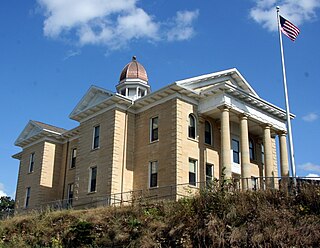
Dodge County is a county in the U.S. state of Minnesota. The population was 20,867 as of the 2020 census. Its county seat is Mantorville.

Austin is a city in, and the county seat of, Mower County, Minnesota, United States. The population was 26,174 at the 2020 census. The town was originally settled along the Cedar River and has two artificial lakes, East Side Lake and Mill Pond. It was named for Austin R. Nichols, the area's first European settler.

Zumbro Falls is a city along the Zumbro River in Wabasha County, Minnesota, United States. The population was 207 at the 2010 census. U.S. Highway 63 and Minnesota 60 intersect in Zumbro Falls.

La Crosse is a city in and the county seat of La Crosse County, Wisconsin, United States. Positioned alongside the Mississippi River, La Crosse is the largest city on Wisconsin's western border. La Crosse's population was 52,680 as of the 2020 census. The city forms the core of the La Crosse–Onalaska metropolitan area, which includes all of La Crosse County and Houston County, Minnesota, with a population of 139,627.
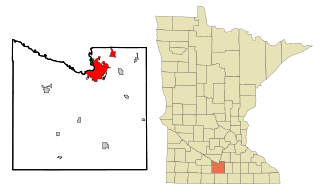
Mankato is a city in Blue Earth, Nicollet, and Le Sueur counties in the U.S. state of Minnesota. It is the county seat of Blue Earth County, Minnesota. The population was 44,488 according to the 2020 census, making it the 21st-largest city in Minnesota, and the 5th-largest outside of the Minneapolis–Saint Paul metropolitan area. It is along a large bend of the Minnesota River at its confluence with the Blue Earth River. Mankato is across the Minnesota River from North Mankato. Mankato and North Mankato have a combined population of 58,763 according to the 2020 census. It completely encompasses the town of Skyline. North of Mankato Regional Airport, a tiny non-contiguous part of the city lies within Le Sueur County. Most of the city is in Blue Earth County.
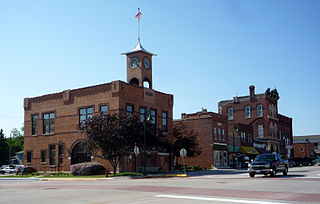
Pine Island is a city in Goodhue and Olmsted counties in the U.S. state of Minnesota. Most of Pine Island is in Goodhue County, but a small part extends into Olmsted County, making that portion part of the Rochester metropolitan area. As of the 2020 census, the population was 3,769.

Eau Claire is a city in Eau Claire and Chippewa counties in the U.S. state of Wisconsin. It is the county seat of Eau Claire County. It had a population of 69,421 in 2020, making it the state's eighth-most populous city. It is the principal city of the Eau Claire metropolitan area, locally known as the Chippewa Valley, and is also part of the larger Eau Claire–Menomonie combined statistical area.

Wausau is a city in and the county seat of Marathon County, Wisconsin, United States, along the Wisconsin River. As of the 2020 census, it had a population of 39,994. It is the core city of the Wausau metropolitan area, which includes all of Marathon County and had a population of 138,013 in 2020. The city's suburbs include Schofield, Weston, Mosinee, Maine, Rib Mountain, Kronenwetter, and Rothschild.

William Worrall Mayo was an English American medical doctor and chemist. He is best known for establishing the private medical practice that later evolved into the Mayo Clinic. His sons, William James Mayo and Charles Horace Mayo, established a joint medical practice in Rochester in the U.S. state of Minnesota in the 1880s.
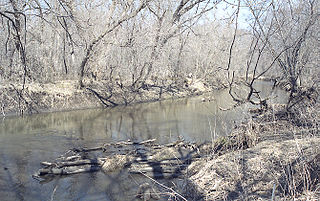
The Zumbro River is a tributary of the Mississippi River in the Driftless Area of southeastern Minnesota in the United States. It is 64.6 miles (104.0 km) long from the confluence of its principal tributaries and drains a watershed of 1,428 square miles (3,700 km2). The river's name in English is a change from its French name Rivière des Embarras due to its mouth near Pine Island in the Mississippi River; the pronunciation changed from to. The Dakota name for this river is Wapka Wazi Oju, having reference to the grove of great white pines at Pine Island.

On August 21, 1883, a devastating tornado affected southeastern portions—the Driftless Area—of the U.S. state of Minnesota. The massive tornado, retrospectively estimated to have been an F5 on the modern Fujita scale, caused at least 37 deaths and over 200 injuries. The tornado was part of a tornado family, a series of tornadoes produced by a supercell, that included at least two significant tornadoes across Southeast Minnesota on August 21. A third significant tornado occurred two hours before the main event hit Rochester. The Rochester tornado indirectly led to the formation of Saint Mary's Hospital, now part of the Mayo Clinic. The tornado closely followed destructive tornadoes a month earlier in the same area: on July 21, two significant, deadly tornadoes hit the area, including an F4 tornado family that killed four people in Dodge and Olmsted Counties, especially near Dodge Center.

The United States Census Bureau defines the Rochester, Minnesota Metropolitan Statistical Area (MSA) as an area consisting of five counties in southeast Minnesota, anchored by the city of Rochester. As of 2018, the US Census Bureau estimates that the Rochester metropolitan statistical area has a population of 221,587. The Rochester–Austin combined statistical area has a population of 259,813 as of 2018.

U.S. Route 63 is a highway in southeastern Minnesota that runs from the Minnesota-Iowa border south of Spring Valley to the Mississippi River at Red Wing. It connects the cities of Spring Valley, Stewartville, Rochester, and Lake City.
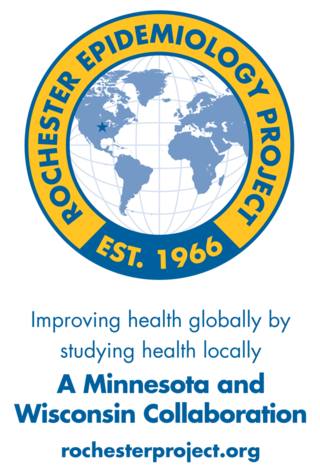
The Rochester Epidemiology Project (REP) is a unique records-linkage research infrastructure that has existed since 1966, and allows for population-based medical research in Olmsted County, Minnesota and an expanded region of 27 counties in Southern Minnesota and Western Wisconsin. The project has been continually funded by the National Institutes of Health since 1966. Specifically, the REP links medical data to unique persons across the many participating medical providers in the region. The project is a collaboration between Olmsted Medical Center, Mayo Clinic, Olmsted County Public Health Services, Mayo Clinic Health System, Zumbro Valley Health Center, and many other historical partners.

Link, previously known as Rochester Rapid Transit and the Downtown Circulator, is a bus rapid transit line planned for downtown Rochester, Minnesota. The 2.6 mile route would connect downtown Rochester, Mayo Clinic's downtown campus, Mayo Clinic's Saint Mary's campus, University of Minnesota Rochester, and a new 13-acre transit-oriented development at the western terminus. Construction is expected to begin in fall 2024, with operations commencing 2026.

The History Center of Olmsted County (HCOC) is a non-profit organization located in Rochester, Minnesota, dedicated to collecting, preserving, and interpreting the history of Olmsted County. Founded in 1926 as the Olmsted County Historical Society.

